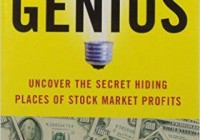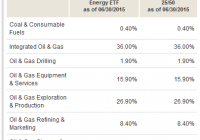Stock Market Genius Made Easy: Spinoffs
Summary Empirical evidence would suggest spinoffs outperform the market. Prior research gives us a rough guide to investing in them. You can simplify the process with online tools and/or an ETF. More than 15 years ago, Joel Greenblatt wrote his masterpiece: You can be a stock market genius. Several other contributors here on Seeking Alpha have sung the book praises. I will be brief: If you haven’t read it, do so. (You could even read it for free by signing up for a free month at Scribd ) Among the strategies Greenblatt discusses, investing in spinoff stocks is one of them. A spinoff is when a company takes a division and separates it, creating a free standalone company. The strategy still works, however, the book was written 15 years ago. In this article, I will: Review briefly the papers proving empirical evidence that spinoff stocks tend to outperform. Rehash a few of Greenblatt’s pointers. Explore tools and strategies, which can simplify the process in 2015. The Empirical Evidence A while ago, John Mcconnell and Alexei Ovtchinnikov wrote a paper studying stocks of both parents and subsidiaries straight after a spinoff occurred between 1965 and 2000. They took the approach of buying the stocks straight after the spinoff and holding them for 36 months. They then computed excess returns in comparison with each stock’s industry, and with stocks with similar size. The results were impressive: The subsidiaries generated substantial ex-post alpha, especially within the first two years of holding the stocks. Source: Predictability Of Long Term Spinoff Returns Even after having adjusted the returns to a Fama-French-Carhart four-factor model, the sample still generated ex-post alpha. If you are interested in the nitty gritty details, I strongly suggest you read the paper. Here are a few points concerning the economic reasoning behind spinoff outperformance: Initial overselling of the security: Following a spinoff, the stock tends to be oversold as institutions which are unable to hold the stock for various reasons (They require dividend-paying stocks, they can’t invest in small caps, etc.) sell the stock. Many individual investors might also sell the spinoff because they want to be invested in the parent only. This depressed price creates an opportunity to find value. Better allocation of resources: Splitting a company into two entities allows each company to focus on creating value through their independent businesses. The destruction of the conglomerate discount: It is a well-known fact that the stock market tends to undervalue conglomerates because of the added complexity in analyzing them. Separating entities often creates pure play stocks in two different businesses. It can therefore be expected that this discount corrects within the first years after a spinoff. Or as Mr. Greenblatt says “Sometimes, Capitalism works” : In other words making the managers of each individual company more responsible, more accountable, and more directly incentivized, often plays out nicely. Greenblatt’s Strategy Throughout his career, Greenblatt has used this market inefficiency for personal gain. In his book, he recounts a few reasons why companies spinoff divisions, other than the obvious “to be better appreciated by the market”: To separate a “bad” business, so that the “good” one can show more of its value. Often they might leave the bad business with massive amounts of debt which can create a leveraged bet, for better or for worse. To create value for investors when a business can’t be sold as a whole, at least not at a reasonable price. To avoid being taxed on the sale of the business. Spinoffs are not taxed when the shares are distributed to the shareholders of the parent company. He also gives a rough hand guide to finding interesting spinoff opportunities: Read the WSJ looking out for upcoming spinoffs. (Don’t worry we’re in 2015 now, it needn’t be that hard, more on that later) Once you’ve found an upcoming spinoff, get your hands on the Form 10 also called general form for registration of securities, and look for some of these cues: Institutions don’t want the spinoff. Questions to ask are: Which current institutions hold the stock? What is their mandate? Are they going to be obliged to sell the spinoff? Insiders want it. Here the focus is on management incentives, including stock options. The idea behind these is that they make managers act like shareholders. There has been quite a debate concerning the effectiveness of such options but when combined with the right elements, they should work. Questions to ask are: Are managers going to be compensated with options? How far out of the money are these options? (Far enough is what you are looking for) Who is going to manage the company? How is management talking about the spinoff? (Watch out they may be talking it down to depress the price) Is what they are saying congruent with their various incentives? If not why not? Finally, usual fundamental analysis must be conducted . Questions to ask are: Is a great stock at a cheap price being uncovered? Has a leveraged bet with an interesting risk/return profile been created? Tools And Strategies in 2015 The economic reasoning for spinoff outperformance seems sound, and the empirical evidence of ex-post alpha is robust. If investors can generate alpha through investing in spinoffs what tools and strategies can they use today to simplify the process? Remember, how I mentioned you didn’t need to read the WSJ every day to find spinoff opportunities? As you might have guessed there is now a website on which you can find all upcoming spinoffs as well as all recent spinoffs . It’s a valuable tool which can be used to find interesting opportunities. Granted, you still need to do the hard work of looking up companies and picking your spots, but at least it is a lot easier. Source: Stockspinoffs.com As you can see, they even named it appropriately. I do want to disclose that I have no business with the website, and am only sharing because it’s an interesting tool. It is also useful to use it to see how spinoffs have performed over time. I will use this tool as a warning. NAME data by YCharts I picked three stocks randomly which spun off in August last year. As you can see these stocks aren’t a promise for riches, and investors should keep that in mind. You can’t just throw darts at a list to pick your spinoffs. You have to do the hard work. Or… you can invest in a quant spinoff ETF. Guggenheim Spin-Off ETF (NYSEARCA: CSD ) The Guggenheim Spin-off ETF seeks to reproduce the returns of the Beacon Spinoff Index before fees which will set you back 0.66% a year. The fund is constructed very similarly with weights changing only modestly. Here is a peak at CSD’s top 20 holdings vs. the index. These account for over 75% of the portfolio in both cases. Source: Guggenheim Investments What is interesting is how this index is constructed. Potential Index constituents include all equities trading on major U.S. exchanges of companies that were spun-off during the two year period beginning 30 months prior to reconstitution and ending 6 months prior to reconstitution. This time frame may be extended to compensate for periods where there are too few new spinoffs to populate the index. The Spin-off Index is comprised of up to of the 40 highest-ranking stocks chosen from the universe of spun-off companies. Each company is ranked using a 100% quantitative rules-based methodology that includes composite scoring of several growth-oriented, multi-factor filters, and is sorted from highest to lowest. Up to 40 stocks are chosen and given a modified market cap weighting with a maximum weight of 4.5%. The constituent selection process and portfolio rebalance is repeated semi-annually, however, if there are not enough new Spin-offs to populate the index, a rebalance may be delayed. What this means is that you will own stocks at the earliest 6 months after they have spun off, and they will be removed at most 36 months after the spinoff (Selection process happens semiannually, and stocks can be included if spun off up to 30 months prior to constituent selection). I have not found any information about their so called rule based ranking. Whether this ranking generates value or not might be questionable, but it can’t be worse than simply ranking stocks by market cap, can it? The index gives each of its 40 stocks a maximum weight of 4.5% whereas CSD weights stocks as high as 5%. So here you go, a no hassle, sleep well at night way to get exposure to spinoffs and their inherent inefficiencies through the first years. How has it performed? This year just as bad as the overall market, over time, a lot better. CSD data by YCharts CSD data by YCharts I will be allocating money towards the CSD ETF as soon as the next transfer makes it to my trading account. Conclusion Spinoffs have beaten the market. Empirical evidence proves it. Sound economic reasoning would suggest they might continue to do so. Great results can be attained by picking your spots. You’ll probably do okay with passive exposure. Disclosure: I/we have no positions in any stocks mentioned, but may initiate a long position in CSD over the next 72 hours. (More…) I wrote this article myself, and it expresses my own opinions. I am not receiving compensation for it (other than from Seeking Alpha). I have no business relationship with any company whose stock is mentioned in this article.

